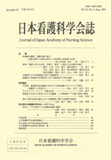Japanese
English
- 販売していません
- Abstract 文献概要
- 参考文献 Reference
要旨
正常分娩経過中の産婦の体温変動を明らかにすることを目的に本研究を行った.正期産で経腟分娩した33例の産婦の体温を継続測定したところ,以下の結果が得られた.なお,測定開始時間は6 : 00~14 : 00とし,子宮口開大5 cm以内から測定を開始した.本研究における“体温”は皮膚温を指標にし,測定には深部温モニター,コアテンプ®CTM-205を使用した.
1.正常分娩時の体温の範囲
中枢深部温の測定値は,34.2~37.9℃の範囲で,個人内の変動幅の平均は1.3±0.6℃だった.末梢深部温は25.7~36.7℃の範囲で,個人内の変動幅の平均は4.1±2.3℃だった.いずれも従来の報告より範囲が広がっていた.腋窩では児娩出時平均が37.1℃で,38℃以上の者が5例あった.しかし分娩12時間後には自然に下降し新生児にも感染徴候を認めなかったことから,分娩時のみの体温の上昇は感染などの異常を生じるものではなかった.
2.個人内温度変化
分娩進行の時間経過にそって有意に温度変化が認められたのは中枢深部温26例で,そのうち上昇15例,下降11例であった.末梢深部温では28例に有意な温度変化が認められ,上昇6例,下降22例であった.
以上より,正常分娩経過において体温は38℃以上になることがあるのを確認した.また,体温変動の傾向としては中枢・末梢ともに上昇・下降・著変なしのいずれも認められた.分娩時には通常の日内変動を越える体温変動が生じることがあり,体温の変動は感染などの異常をアセスメントするだけでなく,分娩進行状況を判断する指標となりうることが示唆された.
Abstract
The purpose of this study was to describe variations in maternal temperature during normal labor. The subjects were thirty-three women experiencing a vaginal birth at term, and were less than 5cm dilated. Their temperatures were measured continuously during the labor period, with the first measurements between 6 and 14 o'clock. In this study, “temperature” indicates skin temperature, measured by the CORETEMP®CTM-205 monitor. The results are as follows: 1. The range of temperature in normal delivery The range for center temperature was 34.2-37.9 degrees, and the mean of the individual temperature variation range was 1.3±0.6 degrees. The range for peripheral temperature was 25.7-36.7 degrees, and the mean of the individual temperature variation range was 4.1±2.3 degrees. This variation was greater than in a previous study. For temperatures taken in the axilla, the mean was 37.1 degrees at the time of delivery, and 5 cases exceeded 38 degrees. High temperature is usually considered a sign of infection. But, if the high temperature occurs only during delivery, it is not considered a sign of infection. (For the women in this study, the temperature decreased naturally during the 12 hours after delivery, and the babies were doing well.) 2. Variations of individual temperature With respect to central temperature, twenty-six out of thirty-three women showed a significant change of temperature as delivery progress, 15 showed a rise in temperature and 11 showed a decrease. With respect to peripheral temperature, twenty-eight of thirty-three women showed a significant change of temperature as delivery progress, 6 showed a rise in temperature and 22 showed a decrease. In studying the above results, I found that maternal temperature might exceed 38 degrees during a normal delivery. The tendency for temperature fluctuation was found in every case-rise, decrease, and no remarkable change. These results suggest that temperature variations may not only be abnormal signs, but may also provide data to assess delivery progress.
Copyright © 2001, Japan Academy of Nursing Science. All rights reserved.


